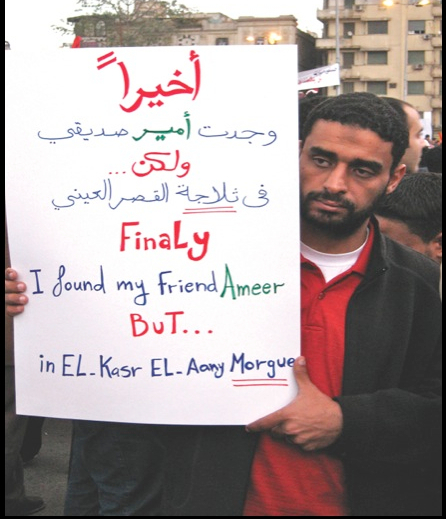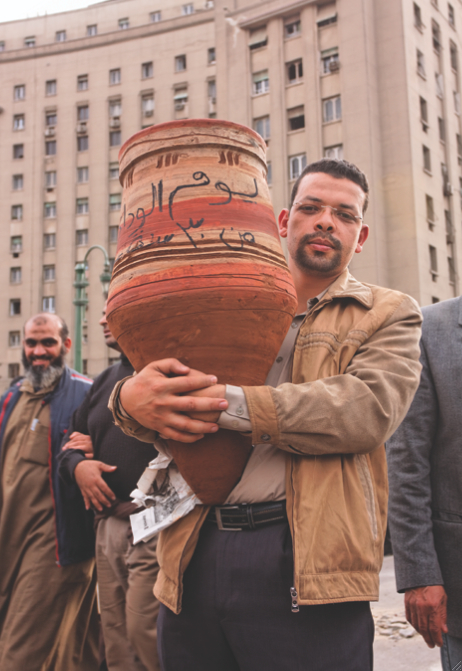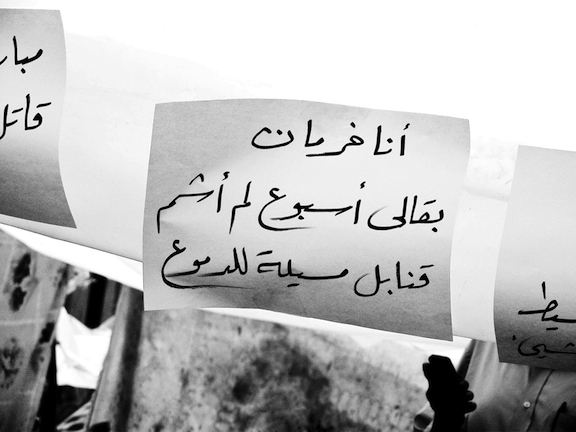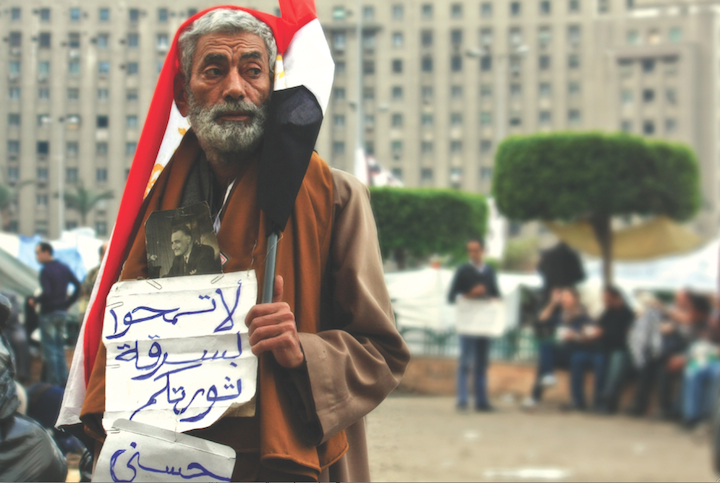Karima Khalil, editor, Messages from Tahrir. Cairo and New York: American University in Cairo Press, 2011.
Jadaliyya: What made you put this book together?
Karima Khalil: One of the first things I saw when I went to Tahrir for the first time on 29 January 2011 was a man standing quietly, holding a sign in Arabic saying: “I used to be afraid but I became Egyptian.” I thought this was an incredibly powerful statement, coming as we did from thirty years of repression with very little public anti-regime protest. I looked around me and saw how many different people—of all ages and backgrounds—were holding signs made from all kinds of things: paper, cardboard, wood, fabric, balloons, and even shoes.
The signs were incredibly expressive; scores were angry, others were extremely poignant. Many were heartrending, held by family members or friends of loved ones killed in the protests: “I finally found my friend Ameer, but in Kasr al Ainy morgue." Many were scathingly irreverent: “EVAEL…maybe he’ll understand if it’s backwards.” Some were purely political: “We demand a new constitution.” Other messages were very personal, like a determined one from a man with a bandaged eye and a lined page torn from a notebook taped to his forehead: “My eye won’t be lost in vain.”

[The battle of Qasr el-Nil Bridge on 28 January 2011. Photo by Islam el-Azzazi.]
People had messages written on their foreheads and on their hands; others spelled out what they wanted to say on the ground with rocks, cups, candles, and even date pits. One protester wrote “Mubarak, you fly away!” on a kite, which soared high above Tahrir Square. These largely homemade, handwritten messages were really powerful and moving. They expressed longings that had been suppressed for so very long. They addressed Mubarak and his hated regime directly but were also aimed at the world: “Here we are, and this is what we want.”
I saw literally hundreds of incredible signs every day: messages that were too heartfelt to be lost, that articulated a unique moment in our history as Egyptians, that had to be documented and seen and heard and shared as widely as possible. Equally importantly, there was (and is) a lot of misinformation about who the protesters were and what they wanted. I felt it was vital to show the real story and I feel that is just as relevant today.
["I used to be afraid, I became Egyptian." Photo by Karima Khalil.]
J: What was particularly Egyptian about these signs?
KK: Many signs drew on very Egyptian cultural references: popular epigrams like ya bakht man zar wa khaffaf (lucky is he who does not outstay his welcome)—very to the point considering that Mubarak ruled for thirty years. Also, people were walking around Tahriri Square holding qollal (clay jugs). In popular Eygptian culture, breaking an qolla after an unwelcome guest ensures they will not be back. One man took this a step further and was holding a zeer (a large clay vessel used for cooling water). Everyone who saw him just cracked up laughing and got his point right away.
Many signs referred to songs—I saw at least two signs quoting Um Kulthum, like this line from her classic Lessa Faker (Do you still think?): “Do you still think my heart can trust you or that a word can bring back what once was.”. Signs reverred to all sorts of puns, rhymes, and chants too, like Mish hanemshi, howwa yemshi (We won’t go, he goes). Countless signs were hilariously funny, reflecting Egyptians’ irrepressible sense of humor: “Hurry up, I’ve got exams!”; “Come on, my arm is aching!”; “Hurry up! I’ve only been married twenty days, and I miss my wife!” And after a week with no reaction whatsoever from the presidency, one of my personal favorites was: “Mr. President, a whole week and not even a phone call?”

[Left: "Finally I found my friend Ameer but...in Kasr al Ainy morgue. Photo by Mariam Soliman. Right: A mother
holds picture of her son, killed in protests. Photo by Shahira Tarek Zaki.]
Many signs reflected developments on the ground. La kalam qabl el ra7il (no talking before he leaves) was the response of four brothers to the regime’s offer to negotiate; they wrote this on tape covering their mouths after their two other brothers were killed in Tahrir. And on and on, I could give you hundreds of examples.


[Left: Breaking an qolla (clay water jug) behind an unwanted guest means they will not come back. This man
brought a whole zeer. Photo by Mohamed Gabr. Right: This creative sign depicts an airport exit stamp with
a superimposed airplane. Photo by Rehab Khalid al-Dallil.]
J: How does this work connect to and/or depart from your previous work?
KK: It does not really relate to anything else I have done. I am a doctor; I work in public health. Photography is a hobby. I thought a photography-based project would be a good way to counter the regime’s powerful disinformation campaign about who the protesters were and what they wanted, without any filters between the reader and images. I thought it would help people see for themselves and make up their own minds.

["I beg you, leave." Photo by Omnia Ibrahim.]
J: How did you collect and choose the particular images that are featured in this book?
KK: I went through about seven thousand photographs, focusing on signs people were holding in Tahrir Square between 25 January and 11 February 2011, the day Mubarak stepped down. Starting with my own photographs, I looked carefully at what the signs said and how powerful the message was. I wanted the images collectively to represent the range of emotions I saw in Tahrir: mourning, rage, determination, pride, sarcasm, steadfastness, good humor, satire, and ultimately celebration, as well as caution. The book shows them in that order. It tells a story.
I picked images for their technical quality and their visual power. I wanted to ensure that the diversity of the protesters came through, so I also looked at who was holding the sign. I considered what the sign was made of as well, since people made signs out of so many different things. When I found an image that I wanted to include in the book, I started the detective work to track down the photographer and ask for permission to use it. Ultimately, thirty-five talented photographers, largely protesters themselves and from all kinds of backgrounds, kindly shared their photographs with me. Short biographies of these generous contributors are included in the book. My only regret is that I could not include more images, as choosing one over another was wrenching. The photographs in Messages from Tahrir represent a very, very small fraction of what is out there.

["I haven`t had any teargas for a week—I`m in withdrawal." Photo by Maged Helal.]
J: Messages from Tahrir is now in its third edition after a mere six months. Who buys the book, and what feedback do you get?
KK: A lot of people who were in Tahrir Square at the time buy the book to remember what it was like, what we were there for, and why we are still protesting; many come up to me and tell me that. Others buy it for those who were not there, that is Egyptians who were not able to be in Tahirir Square or who live abroad and who would have liked to have been part of that heady period. Foreigners curious about our revolution buy it as well. An English friend of mine gave a copy to two Egyptian doctors working in Scotland who broke down and cried as they turned the pages. They sent me a message saying it made them feel as if they had been there. I hear that a lot. I am incredibly privileged. I experienced Tahrir, and I was able to bring a small part of it to others.

["Half a revolution is a nation lost." Photo by Mohamed Ezz Aldin.]
[Note: All royalties from Messages from Tahrir go to the Cairo-based Nadeem Center for the Rehabilitation of Victims of Torture.]

["Do not let your revolution be stolen." Photo by Omnia Ibrahim.]
[All images from Karima Khalil, editor, Messages from Tahrir. © 2011 by the American University of Cairo Press. For more information, click here; to order the book, click here.]